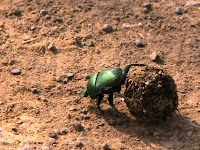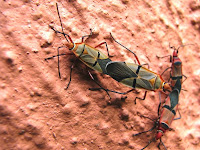 There are more species of beetles than any other order in the animal kingdom - constituting approx. 25% of all known life-forms. Taking this into account it's difficult to identify a beetle if you aren't an expert on the subject. Beetles have mouthparts similar to grasshoppers - e.g. mandibles, which appear as large pincers on the front of some beetles. The legs are multi-segmented & like many other insects, beetles bear claws at the end of each leg. The antennae of beetles are primarily organs of smell - other than to "feel out" the environment.
There are more species of beetles than any other order in the animal kingdom - constituting approx. 25% of all known life-forms. Taking this into account it's difficult to identify a beetle if you aren't an expert on the subject. Beetles have mouthparts similar to grasshoppers - e.g. mandibles, which appear as large pincers on the front of some beetles. The legs are multi-segmented & like many other insects, beetles bear claws at the end of each leg. The antennae of beetles are primarily organs of smell - other than to "feel out" the environment.
Did you know that 'beetle' is derived from the Old English word bitan - meaning to bite (= chewing & biting, instead of sucking)?
 The largest taxonomic family of beetles are the weevils (or snout beetles). Now weevils are generally "better known" as occuring in dry foods (including nuts & seeds, as well as cereal & grain products) & most likely can be observed in flour - "indicated" by the granules sticking together in strings, as if caught in a cobweb. Those are the "primitive" weevils, usually small (less than 6mm). In contrast a "true" weevil is a beetle - still commonly regarded as a pest - which has an exeptionally hard elytra (eleytron = 1 of 2 wing-cases of a beetle) & therefore, it's difficult to destroy.
The largest taxonomic family of beetles are the weevils (or snout beetles). Now weevils are generally "better known" as occuring in dry foods (including nuts & seeds, as well as cereal & grain products) & most likely can be observed in flour - "indicated" by the granules sticking together in strings, as if caught in a cobweb. Those are the "primitive" weevils, usually small (less than 6mm). In contrast a "true" weevil is a beetle - still commonly regarded as a pest - which has an exeptionally hard elytra (eleytron = 1 of 2 wing-cases of a beetle) & therefore, it's difficult to destroy.
 Another look at another weevil with a longer "rostrum" (= snout) as well as much longer antannea. In some species this characteristic snout is short & squad, in others long & narrow. A weevil's exclusively vegetarian diet includes numerous agricultural crops - other than "attacking" newly emerged leaves of garden bulbs.
Another look at another weevil with a longer "rostrum" (= snout) as well as much longer antannea. In some species this characteristic snout is short & squad, in others long & narrow. A weevil's exclusively vegetarian diet includes numerous agricultural crops - other than "attacking" newly emerged leaves of garden bulbs.

Characteristically beetles have hardened shield-like forewings (= not used for flight) but underneath have a 2nd pair of (hind) flight wings. However some ground beetles - like the "true" weevils as well as a dung beetle endemic to e.g. the Addo Elephant Park (in the Eastern Cape Province) - have "lost" the ability to fly.
 There are several species of dung beetle, also known as "scarab" (from family Scarabaeidae) & which had a sacred status amongst ancient Egyptians. Dung beetles have shovel-like heads for burying their "precious" ball of dung (either as food storage or as a brooding ball). By consuming the dung, these beetles improve nutrient recycling & soil structure.
There are several species of dung beetle, also known as "scarab" (from family Scarabaeidae) & which had a sacred status amongst ancient Egyptians. Dung beetles have shovel-like heads for burying their "precious" ball of dung (either as food storage or as a brooding ball). By consuming the dung, these beetles improve nutrient recycling & soil structure.
 This also "improves" the environment because by removing dung which, if left, could provide a habitat for pests like flies. Dung beetles vary in colour from black to brown, or a metallic green, blue or bronze.
This also "improves" the environment because by removing dung which, if left, could provide a habitat for pests like flies. Dung beetles vary in colour from black to brown, or a metallic green, blue or bronze.
 Like a dung beetle, the Rhinoceros beetle is a member of the Scarabaeidae family. Only the male Rhino beetles have the characteristically large horns, which they use to fight other males during the mating season, although the horns also function as "built in" digging tools.
Like a dung beetle, the Rhinoceros beetle is a member of the Scarabaeidae family. Only the male Rhino beetles have the characteristically large horns, which they use to fight other males during the mating season, although the horns also function as "built in" digging tools.
 Is this perhaps a female rhino beetle (since it looks similar but doesn't "possess" a proper horn)? As I've indicated, I had to do quite a bit of research before being able to identify at least some of the insects I've photographed through the years. Rhino beetles are also known as Hercules, Unicorn or horn beetles.
Is this perhaps a female rhino beetle (since it looks similar but doesn't "possess" a proper horn)? As I've indicated, I had to do quite a bit of research before being able to identify at least some of the insects I've photographed through the years. Rhino beetles are also known as Hercules, Unicorn or horn beetles.
 After not knowing if this was a beetle or bug, I luckily found a "replica" in the (small book): Sasol Field Guide to Insects of Southern Africa. It's a Tiger beetle & this family of Ground beetles is described as very fast-running beetles with long, slender legs. The head is broad with prominent eyes & they have long antennae.
After not knowing if this was a beetle or bug, I luckily found a "replica" in the (small book): Sasol Field Guide to Insects of Southern Africa. It's a Tiger beetle & this family of Ground beetles is described as very fast-running beetles with long, slender legs. The head is broad with prominent eyes & they have long antennae.
 Talking about bugs - I've previously posted this photo of Shield bugs - but want to use it again to "demonstrate" that bugs are quite different from beetles: bugs have sucking or piercing mouthpieces (instead of being able "to bite" like beetles). In addition bugs almost always have 2 pair of wings. Amongst the bugs are some of the smallest but also some of the largest insects found all over our country.
Talking about bugs - I've previously posted this photo of Shield bugs - but want to use it again to "demonstrate" that bugs are quite different from beetles: bugs have sucking or piercing mouthpieces (instead of being able "to bite" like beetles). In addition bugs almost always have 2 pair of wings. Amongst the bugs are some of the smallest but also some of the largest insects found all over our country.
 However in English, any offensive little insect is often referred to as a "bug". Similarly in Afrikaans, gogga is used to describe any small animal that crawls or flies. Did you know that gogga is derived from the Khoikhoi word xoxon?
However in English, any offensive little insect is often referred to as a "bug". Similarly in Afrikaans, gogga is used to describe any small animal that crawls or flies. Did you know that gogga is derived from the Khoikhoi word xoxon?











No comments:
Post a Comment